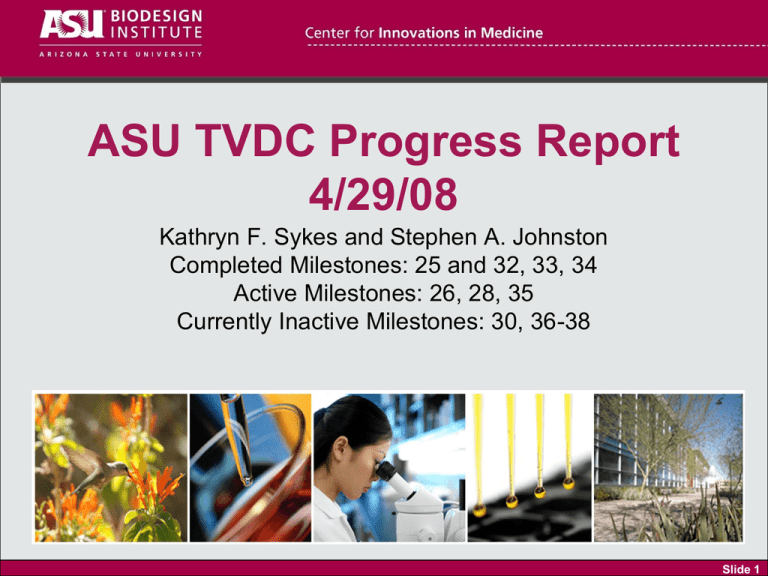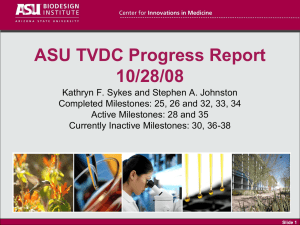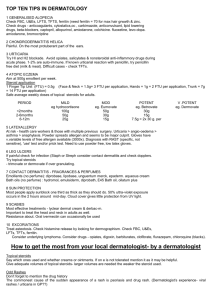ASU TVDC Progress Report 4/29/08
advertisement

ASU TVDC Progress Report 4/29/08 Kathryn F. Sykes and Stephen A. Johnston Completed Milestones: 25 and 32, 33, 34 Active Milestones: 26, 28, 35 Currently Inactive Milestones: 30, 36-38 Slide 1 MILESTONE 26 Prepare a highthroughput protein production system Gray: (sub )milestone title Red: completed or inactive Green: in progress Test ORF synthesis and select expression constructs Select and test IVT Protocols Select and test protein purification protocols Completed. Expression templates for prokaryotic expression are optimized Completed. High yield IVT protocols are optimized Alternative Purification strategies have been identified Slide 2 Milestone 26 ML26-1 – completed ML26-2 – completed ML26-3 – pending a. Construction of a thioredoxin fusion plasmid for protocol testing. b. Evaluation of preclearing Ni beads before use in purification c. Evaluation of co-incubating Ni beads during IVT reactions Slide 3 ML26-3. Previous Status • Proper conformation appears to be critical for efficient separation of cross-reacting molecules from polypeptides by: • size filtration • acetone precipitation • Affinity (Ni-binding) purification • Decision was made to evaluate methods to improve folding or alternative methods of purification that are folding-independent. Slide 4 ML26-3. Update Construction of a thioredoxin fusion plasmid for use as LEE PCR template and for recombinant protein production during testing. Slide 5 Thio-fusion LEE ORF T7-Pro T7-Pro Thio. Thio. T7-Term 6-His 6-His ORF T7-Term Slide 6 Thio-fusion plasmid constructs • Design primers to use for PCR amplification of FTU ORF from perfect clone. • Cloning of FTU ORF into pET32b Slide 7 Thio fusion cloning into pET32b 1 1 2 6 2 3 4 3 4 5 6 7 7 8 5 1 8 2 3 4 9 9 Double digestion of FTU ORFs 1-9: Ova, FTU 721A, FTU 721B, FTU 721C, FTU 901, FTU 1695, FTU 1696 Aa, FTU 1696 Ba, and FTU1712 pET32b double digestion 1: EcoR1 digestion 2: XHoI digestion 3: EcoR1 and XHoI digestion 4: Uncut pET32b Slide 8 ML26-3. Update Evaluation of pre-clearing beads before use in purification and Evaluation of co-incubating beads during IVT Slide 9 IVT “as is” and standard purification from Ni magnetic beads Coomassie Autoradiograph 1 1 2 3 4 5 6 7 1,2. Ovalbumin 8 2 3 4 5 6 7 8 9 10 11 12 13 14 15 16 17 18 9 10 11 12 13 14 15 16 17 18 11,12. FTU 1695 3,4. FTU 721A 13,14. FTU 1696Aa 5,6. FTU 721B 15,16. FTU 1696Ba 7,8 FTU 721C 17,18. FTU 1712 Odd numbers: IVT Even numbers: Elution 9,10. FTU 901 Slide 10 Optimizing amount of Ni-magnetic bead to use for purification 1 2 3 4 5 6 7 8 9 10 1 SDS gel 2 3 4 5 6 7 8 9 10 autoradiograph 1: IVT, 2: blank Odd numbers (except 1): Supernatant 3,4: 5ul Even numbers ( except 2): Elution 5,6: 10ul Sample is the mixture of: Ova, FTU 721A , FTU 721C, 7,8: 15ul FTU 1695, and FTU 1696Aa 9,10: 20ul Slide 11 LEE construction for Rabit Retic IVT 1 2 3 4 5 6 7 8 9 10 1. Ovalbumin 2. FTU 721A 3. FTU 721B 4. FTU 721C 5. FTU 1696Aa 6. FTU 1696Ba 7. Calm3 (Not Used) 8. FTU 901 9. FTU 1712 10. FTU 1695 Slide 12 Comparison of total yields from E.coli vs. Rabbit retic IVT E.coli lysate (total ug) Rabbit Reticulocytes (total ug) Ova 68.04 0.003 FTU 721A 28.72 0.002 FTU 721B 18.69 0.003 FTU 721C 6.51 0.003 FTU 901 27.28 0.004 FTU 1695 17.46 0.005 FTU 1696 Aa 27.67 0.003 FTU 1696 Ba 123.44 0.006 3.43 0.007 Template FTU 1712 Calculation of based on 100ul reaction in E.coli, and 50ul in RR IVT Slide 13 Effect of E. coli lysate preclearing on total IVT yield Total protein (ug) 20 18 Ova 16 FTU 1695 14 12 10 8 6 4 2 0 0 25 50 100 Amount of beads (ul) Slide 14 Effect of pre-clearing E.coli lysate on yield of polypeptide binding to Ni-beads Bead volume: Ova FTU 1695 Without preclearing IVT Sup (ug) (ug) Bound to bead 25 ul IVT Sup (ug) (ug) 17.04 11.40 5.63 15.5 8.73 1.12 7.61 6.9 7 Bound to bead 50 ul 2.5 4.4 IVT Sup (ug) Bound to bead (ug) (ug) Bound to bead 6.9 10.4 9.8 4.1 5.7 3 6.6 3.7 1.3 2.4 IVT Sup (ug) 8.5 17.3 9.6 100 ul Slide 15 Effect of urea vs. co-incubation of beads during IVT reaction on efficiency of polypeptide binding to magnetic Ni beads ova FTU 721A FTU 721B FTU 721C FTU 901 FTU 1695 FTU1695Aa FTU1696Ba FTU 1712 GFP-trix 1 23 1 2 312 3 1 2 31 2 3 1 231 23 12 3 1 2 31 23 1: 10ul IVT 2: 20ul supernatant of 6M urea denatured protein bound on Ni magnetic beads 3: 10ul supernatant from protein purification from Ni magnetic beads incubated during IVT reaction (All have been normalized to 10% of total volume) Slide 16 Effect of blocking Ni beads with fetal bovine sera prior to polypeptide binding Without blocking (8M urea) FBS blocking Ova 81% 61% FTU 1695 80% 65% Data represents estimated percentage of proteins bound to the beads Slide 17 Samples for UNM Elispot-Trial 1 1. 2. 3. 4. 5. 6. FTU protein with E.coli IVT “as is”. Traditional affinity purification using Ni magnetic beadsElution fraction. Incubation of Ni beads during IVT reaction. Beads were washed. After washing, the beads were resuspended in PBS. Denature IVT proteins with 6M urea prior to binding to the Ni magnetic beads. After washing, the beads were resuspended in PBS. Substitute Ni-magnetic beads with protein G-beads. IVT proteins bound to the beads via anti-His antibody. Beads were washed. After washing, the beads were resuspended in PBS. FTU protein with Rabbit Reticulocyte IVT “as is”. Slide 18 ELISpot of splenocytes from Ova mice Ovalbumin Ovalbumin(1/10) FTU 721A FTU 721B Headings for FTU rows Column 7: IVT “as is” Column 8: elution IVT fraction after dialysis Column 9: non-denatured IVT proteins bound to beads Column 10: 6M urea denatured proteins bound to beads Column 11:IVT proteins bound to protein G Column 12:Rabbit retic IVT “as is” FTU 721C FTU 901 FTU 1695 Control row: FTU 1696Aa FTU 1712 FTU 1696Ba Control row: Control row: No Ag OVA peptide Sigma OVA protein Blank protein G beads Blank Ni beads IVT no template (C12) Slide 19 ELISpot of splenocytes from vaccinated mice Ovalbumin Ovalbumin(1/10) Headings for FTU rows Column 7: IVT “as is” Column 8: elution IVT fraction after dialysis Column 9: non-denatured IVT proteins bound to beads Column 10: 6M urea denatured proteins bound to beads Column 11:IVT proteins bound to protein G Column 12:Rabbit retic IVT “as is” FTU 721A FTU 721B FTU 721C FTU 901 FTU 1695 Control row: FTU 1696Aa FTU 1712 FTU 1696Ba Control row: Control row: No Ag OVA peptide Sigma OVA protein Blank protein G beads Blank Ni beads IVT no template (C12) Slide 20 Samples for UNM Elispot-Trial 2 1. Clearing of Ni binding proteins from E.coli lysate prior to IVT reaction 2. Blocking Ni magnetic beads with Fetal Bovine Sera prior to binding of FTU proteins to the beads Slide 21 O V A L V S Sample rows control rows ivt no template 25 µL Ni beads Sigma OVA protein OVA 25 FTU 1695 µL Ni 25 µL Ni beads beads Sigma OVA protein Sigma OVA protein ivt no template 50 µL Ni beads OVA peptide ivt no OVA 50 FTU 1695 template OVA FTU 1695 µL Ni 50 µL Ni 100 µL Ni 100 µL Ni 100 µL Ni beads beads beads beads beads OVA peptide OVA peptide No Ag No Ag ivt no template BSA OVA BSA FTU 1695 BSA No Ag Slide 22 Conclusions • Adding the Ni beads during the IVT reactions significantly improves polypeptide “capture”, thereby improving yields • Pre-clearing the IVT lysates with beads prior to IVT, significantly reduces nonspecific T cell reactivity • …Without reducing specific reactivity Slide 23 Go/No Go decisions update • We will prepare all antigen samples as described above- E. coli purified and Rabbit Retic unpurified -to UNM. • Based on antigen specfic and nonspecific reactivities in UNM ELISpot assays we will select a method for antigen production. Slide 24 MILESTONE 28 Build SCHU S4 proteome Gray: (sub)milestone title Red: inactive Green: in progress Build ORF expression library corresponding to proteome Generate complete protein-fragment library Array protein-fragments into measurable pools For T cell stimulation Active On-hold Inactive Slide 25 MILESTONE 35 Array hybridations with mouse RNAs from virulent Schu 4 infection & RT PCR confirmation of candidates Gray: (sub )milestone title Red: completed Green: in progress Virulent Schu 4 Samples RT-PCR Confirmations Initial samples Dose-Response and Time Course of Infection QPCR Primers in Design Slide 26 Previous Status •Initial studies performed with two biological experiments focusing on dose-response of challenge •Initial time was 4 hours post-challenge •RNA from each experiment was amplified twice and the most consistently detected genes were combined from the key doses (103-107) •141 genes listed Slide 27 Time Course of Gene Expression Changes Decreasing Signal Intensity Increasing T0 T1 T3 T5 T7 T24 T1 T3 T5 T7 T24 T0 Slide 28 Overlap of Increasing and Decreasing with the Dose Response Picks Decreasing Increasing 6 94 91 0 0 2 139 141 – 4 Hr Dose Response Slide 29 Signal Intensity Expression Patterns of Putative Vaccine Candidates T0 T1 T3 T5 T7 T24 Slide 30 Expression Levels of Two Genes Identified By Multiple Assays FTT1616 FTT0031 Cysteinyl-tRNA synthetase NADH dehydrogenase I, A subunit Slide 31 Conclusions • Initial time course analysis reveals genes of increasing and decreasing expression during the first 24 hours of infection • There is minimal overlap with the 4 hour gene list identified from the dose response experiments Slide 32 Upcoming Transcriptome Goals • Q-PCR validation of the hits • Primers being designed • groEL / icglC / dnaK / tul4 / katG • Time Course Experiment • Repeat amplification of time course samples • Parallel cultures in Chamberlain’s medium Slide 33 Action Items • Kathy: titrate above 20ul of Ni beads to possibly improve yield of purified IVT products • Mitch/Rick/Stephen: At the 5/16/08 ASU site visit, we need to plan the other gene expression experiments to accomplish in the remaining time of the ASU subcontract perhaps using other tissues, beside the lungs, comparing rat vs mouse as different species, etc. Microarrays are running well, so now need a pipeline in place. Slide 34 MILESTONE 35 Array hybridations with mouse RNAs from virulent Schu 4 infection & RT PCR confirmation of candidates Gray: (sub )milestone title Red: completed Green: in progress Virulent Schu 4 Samples RT-PCR Confirmations Initial samples Dose-Response and Time Course of Infection QPCR Primers in Design Slide 35 Previous Status •Initial studies performed with two biological experiments focusing on dose-response of challenge •Initial time was 4 hours post-challenge •RNA from each experiment was amplified twice and the most consistently detected genes were combined from the key doses (103-107) •141 genes listed Slide 36 Time Course of Gene Expression Changes Decreasing Signal Intensity Increasing T0 T1 T3 T5 T7 T24 T1 T3 T5 T7 T24 T0 Slide 37 Overlap of Increasing and Decreasing with the Dose Response Picks Decreasing Increasing 6 94 91 0 0 2 139 141 – 4 Hr Dose Response Slide 38 Signal Intensity Expression Patterns of Putative Vaccine Candidates T0 T1 T3 T5 T7 T24 Slide 39 Expression Levels of Two Genes Identified By Multiple Assays FTT1616 FTT0031 Cysteinyl-tRNA synthetase NADH dehydrogenase I, A subunit Slide 40 Conclusions • Initial time course analysis reveals genes of increasing and decreasing expression during the first 24 hours of infection • There is minimal overlap with the 4 hour gene list identified from the dose response experiments Slide 41 Upcoming Transcriptome Goals • Q-PCR validation of the hits • Primers being designed • groEL / iglC / dnaK / tul4 / katG • Time Course Experiment • Repeat amplification of time course samples • Parallel cultures in Chamberlain’s medium Slide 42 Action Items • Kathy: titrate above 20ul of Ni beads to possibly improve yield of purified IVT products • Mitch/Rick/Stephen: At the 5/16/08 ASU site visit, we need to plan the other gene expression experiments to accomplish in the remaining time of the ASU subcontract perhaps using other tissues, beside the lungs, comparing rat vs mouse as different species, etc. Microarrays are running well, so now need a pipeline in place. Slide 43

